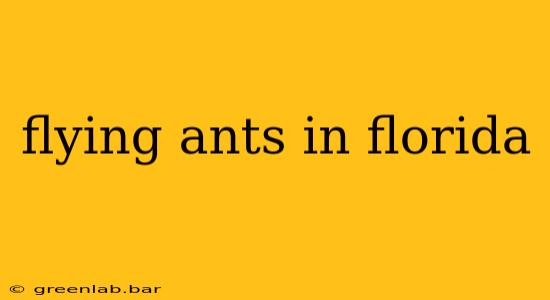Florida's warm, humid climate provides the perfect breeding ground for a variety of ant species, many of which take to the air during their mating season. This swarming phenomenon, often mistaken for termites, can be alarming, but understanding the behavior of these flying ants can help you manage them effectively. This guide delves into the common types of flying ants found in Florida, their identification, and effective control methods.
Identifying Flying Ants in Florida
Unlike termites, which have straight antennae and a broad waist, flying ants possess bent antennae and a narrow waist. However, differentiating between flying ants and termites can still be challenging for the untrained eye. Here's a closer look at some key characteristics:
Common Florida Flying Ant Species:
-
Sugar Ants (various species): These are among the most prevalent flying ants in Florida. They are typically small to medium-sized, and their colonies can be extensive. They are attracted to sweet substances, hence their name.
-
Carpenter Ants ( Camponotus species): Larger than sugar ants, carpenter ants are easily identifiable by their size and the potential damage they cause to wood structures. While they don't eat wood, they excavate nests within it, weakening the structural integrity.
-
Odorous House Ants ( Tapinoma sessile): These ants are known for their characteristic coconut-like odor when crushed. They are relatively small and often found indoors, nesting in damp areas.
Key Differences Between Flying Ants and Termites:
| Feature | Flying Ants | Termites |
|---|---|---|
| Antennae | Bent or elbowed | Straight |
| Waist | Narrow (distinct segmentation) | Broad (less distinct segmentation) |
| Wings | Front wings significantly larger than hind wings | Front and hind wings of similar size |
| Body Shape | More defined segmentation | More uniform body shape |
| Damage | Minimal structural damage (except carpenter ants) | Significant structural damage to wood |
Dealing with Flying Ant Swarms in Your Florida Home
A sudden swarm of flying ants is a common occurrence in Florida, often peaking during specific times of the year depending on the species. While a single swarm may not indicate a massive infestation, it's a clear sign of an existing colony nearby.
Effective Control Strategies:
-
Identify the Source: Locate the entry points where the ants are entering your home. This is crucial for effective control. Follow the ants' trail to find the nest.
-
Professional Pest Control: For extensive infestations, especially carpenter ants, professional pest control is highly recommended. They have the expertise and tools to effectively eliminate the colony and prevent future infestations.
-
Preventative Measures: Seal cracks and crevices in your home's foundation and walls. Maintain good sanitation practices, storing food properly and cleaning up spills promptly. Eliminate sources of moisture, as ants are attracted to damp areas.
-
Baits: Ant baits can be effective in controlling infestations, especially for sugar ants. These baits contain slow-acting insecticides that ants carry back to the colony, leading to its eventual eradication. However, patience is key as it may take time for the bait to take full effect.
-
Natural Repellents: Some homeowners opt for natural repellents like diatomaceous earth or peppermint oil, although their effectiveness can vary.
When to Call a Professional
While many minor ant infestations can be managed independently, it's crucial to seek professional help when:
- You have a large or persistent infestation.
- You suspect carpenter ants are present, due to the potential structural damage.
- You are uncertain about the species of ant and its behavior.
- DIY methods have proved ineffective.
Understanding the behavior and identification of flying ants in Florida is vital for effective management. This comprehensive guide should help Florida homeowners address these common pests confidently. Remember, prevention is key, and prompt action is crucial to avoid larger infestations.

